Hands on Time | The Illusion of the End
 The Illusion of the End, Mudam’s two-week performance exhibition program curated by Joel Valabrega, successfully reveals and questions the unstable agency of the spectatorship, emphasizing its relationship to space, the gaze of others, and, most importantly, the notion of time.
The Illusion of the End, Mudam’s two-week performance exhibition program curated by Joel Valabrega, successfully reveals and questions the unstable agency of the spectatorship, emphasizing its relationship to space, the gaze of others, and, most importantly, the notion of time.
Gathering some of the most compelling artists of the contemporary European performative scene ⎯ such as the Swiss duo Pauline Boudry and Renate Lorenz, the Italian choreographer Jacopo Jenna, the Dutch-Polish combo Nicholas Grafia and Mikołaj Sobczaka, and the anonymous Russian collective Vasya Run ⎯ the program unfolds through hyperboles of action and moments of void, where performance becomes a weapon to negotiate new forms of perception of time in space.
Through several live performance sessions and video installations, the exhibition activates the ground floor of the museum, centering its rollout in the two side galleries that serve as bare, aseptic virgin caves open to host new gestures. In these spaces, artists are invited to confront the void. Whether the performative bodies are onstage or offstage (or simply video projections), the galleries become an arena of practice for the viewer as well, who engages in exercises of vision as much as action. The strategies developed by artists to relocate the viewer for a new form of sensory experience ⎯ one that calls into question the time of fruition (as a time of life) ⎯ are varied and multifaceted.
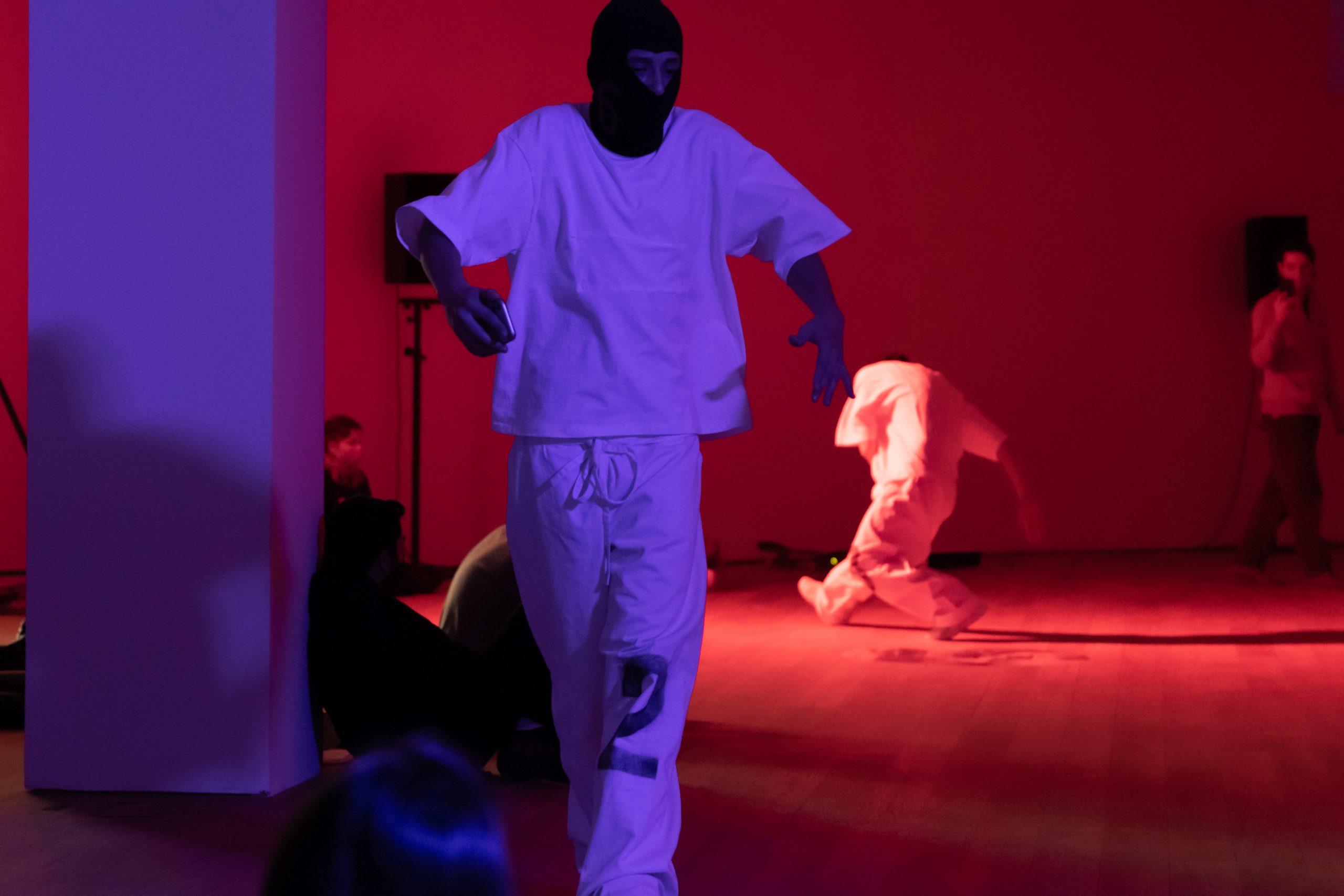 Vasya Run doesn’t mince words and explicitly calls upon his lay faithful: Stay here ⎯ you are the main act is a performance conceived for the occasion, an invitation to relationship and confrontation. The viewer faces four young Muscovites with no background in the performing arts who undergo an intensive program “designed to address their experiences of anxiety whilst exploring the boundaries of self-awareness and introspection.”
Vasya Run doesn’t mince words and explicitly calls upon his lay faithful: Stay here ⎯ you are the main act is a performance conceived for the occasion, an invitation to relationship and confrontation. The viewer faces four young Muscovites with no background in the performing arts who undergo an intensive program “designed to address their experiences of anxiety whilst exploring the boundaries of self-awareness and introspection.”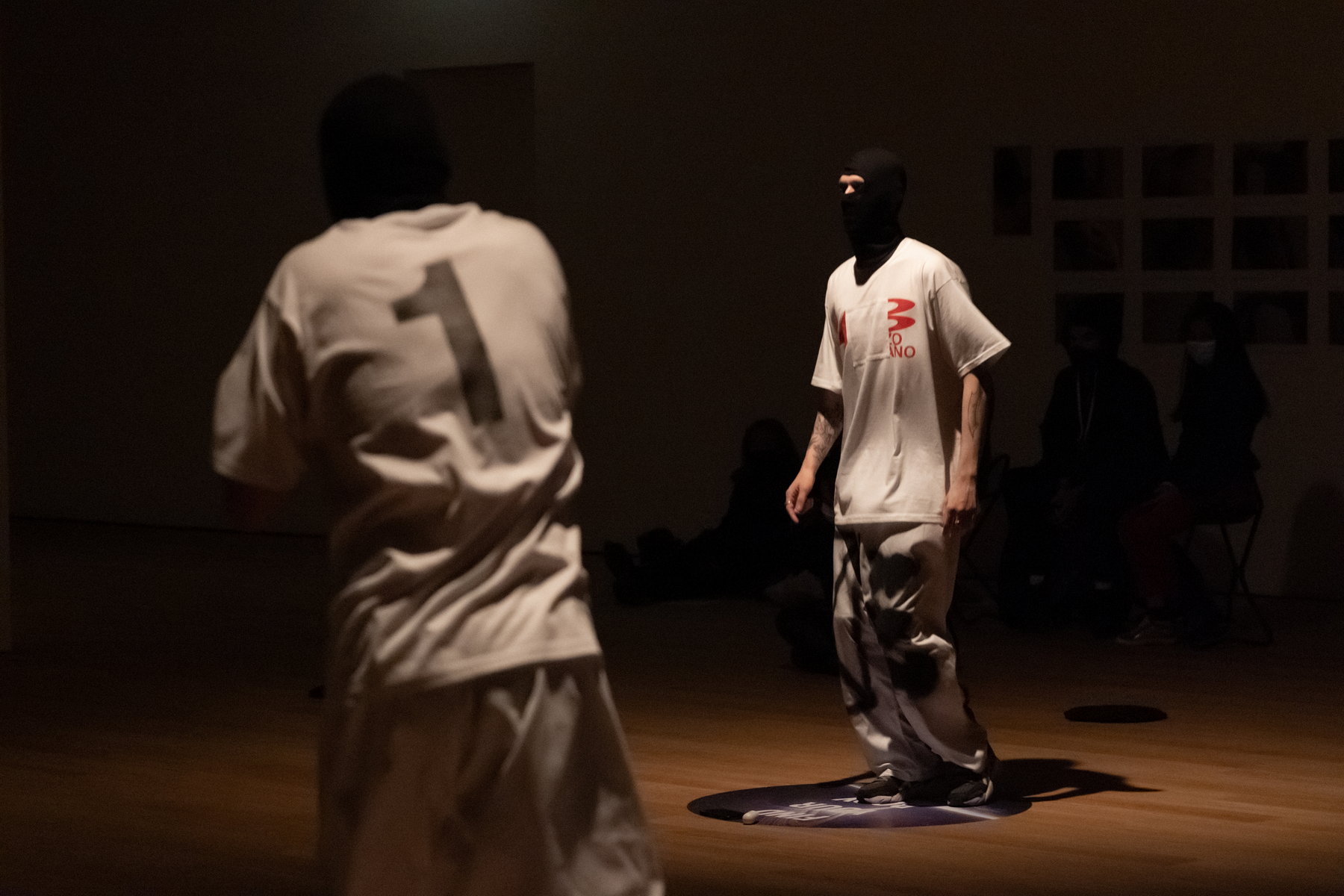
Instead, folk tales and marginalized mythology are the ghosts that haunt Nicholas Grafia and Mikołaj Sobczak’s Rooms, a thirty-minute scripted performance that delves into the personal memories, dreams, and latent feelings possessing the characters on stage. The bodies become “personification of phantoms of past events inhabiting the performers” where the artificiality and theatricality of the action are emphasized and extreme, revealing an overturning of the unconscious that, thus now externalized, becomes a dynamic and informal environment, a force field in which the different tensions that shape desire clash.
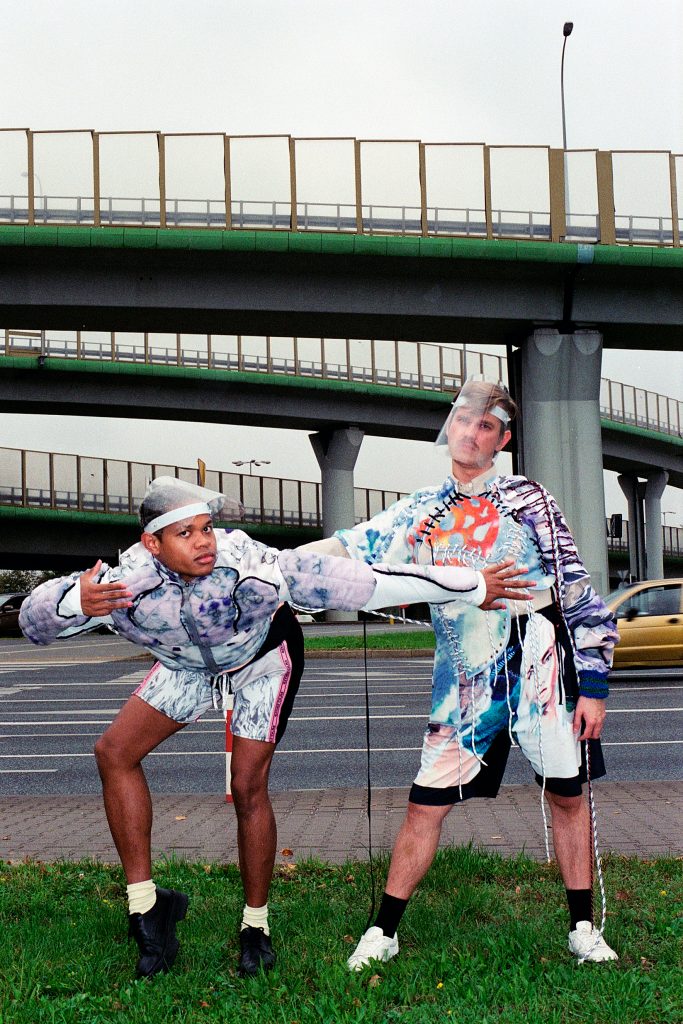 In parallel, Pauline Boudry and Renate Lorenz operate in the gallery space through a film installation within an “abstract club;” Moving Backwards is the result of a practice that engages with strategies of active resistance in terms of gender, sexual and refugee rights. Originally conceived for the Swiss Pavilion’s exhibition at the Venice Biennale in 2019, it finds Luxembourg the perfect venue for its second debut (meanwhile, a group exhibition on the first floor with the emblematic title Post-Capital is also on view). The video, which combines performance and digital manipulation, physically manifests the push and pull of resistance and backlash in the manner of Kurdish women: “it seems they are moving backwards, because their shoes leave traces in one direction in the snow. But actually, they are moving forwards.”
In parallel, Pauline Boudry and Renate Lorenz operate in the gallery space through a film installation within an “abstract club;” Moving Backwards is the result of a practice that engages with strategies of active resistance in terms of gender, sexual and refugee rights. Originally conceived for the Swiss Pavilion’s exhibition at the Venice Biennale in 2019, it finds Luxembourg the perfect venue for its second debut (meanwhile, a group exhibition on the first floor with the emblematic title Post-Capital is also on view). The video, which combines performance and digital manipulation, physically manifests the push and pull of resistance and backlash in the manner of Kurdish women: “it seems they are moving backwards, because their shoes leave traces in one direction in the snow. But actually, they are moving forwards.”

Finally, the interventions of Jacopo Jenna, which I had the chance to experience live in first person. His work is divided into two macro performative moments: four Modules of about 15 minutes each are indeed the prelude to the main performance If, If, If, Then (Expanded Version). The exercise in its complexity is an attempt to formalize two-dimensional poses soon to be erased and re-enacted. The three performers who bring Jenna’s choreography to life improvise over codified tracks. They are not bodies of desire, but sketches of kinetic thought, traces of fixed choreographic imagery that tend towards the abstraction of gesture rather than the stabilization of form. Jenna’s practice is as complex as it is delicate; his performances mobilize such a quantity of repertoires and visual culture references that even the most expert spectator risks getting lost in the labyrinth of unstable poses that they perform. And yet Jenna reaches everyone, he is so transversal that even a performance illiterate (perhaps, much more than others!) would find in his choreographies reason for amusement or even reflection. There are many levels of interpretation, just as there are many gestural hints in play.
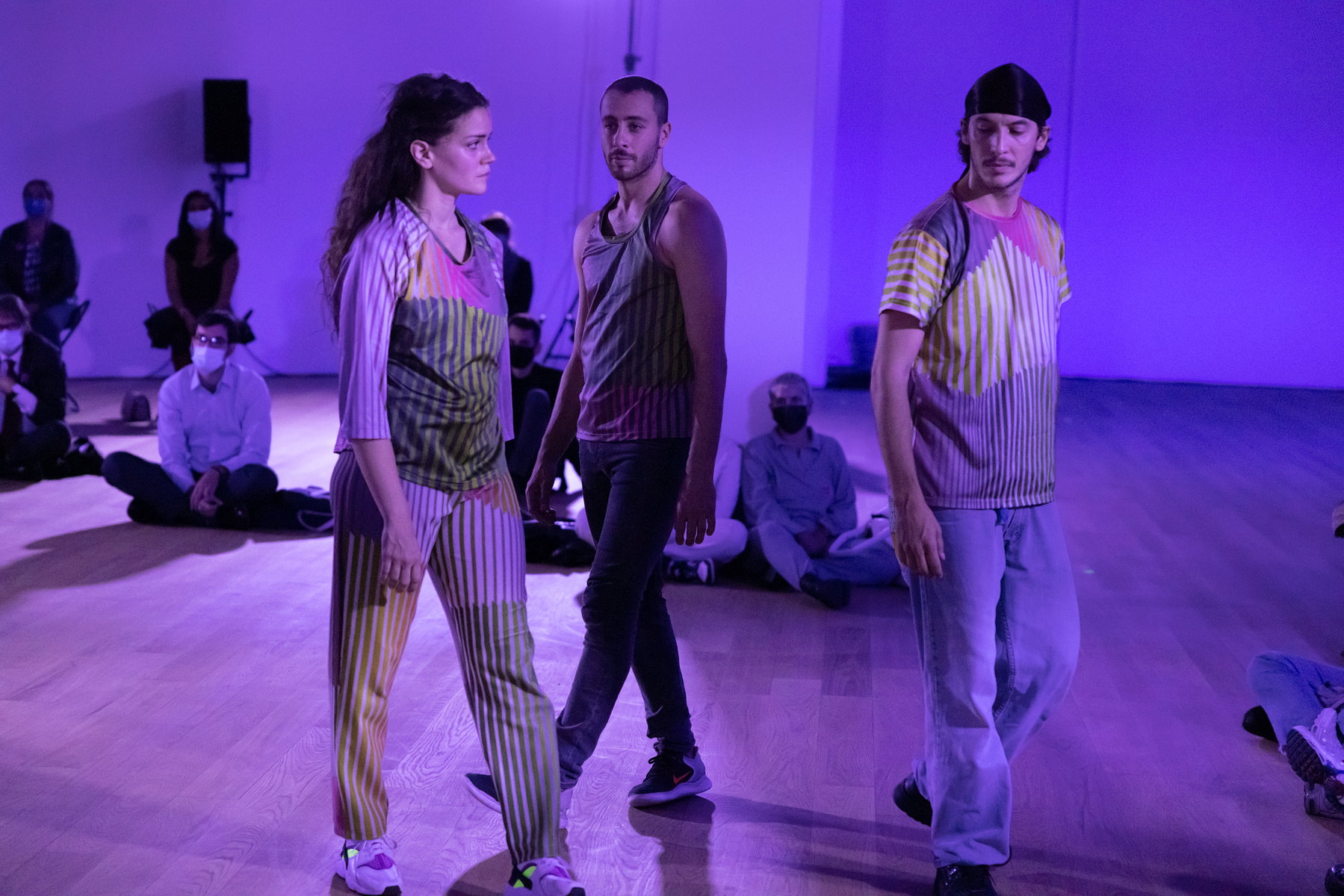
In the Modules, music does not exist. But nevertheless silence materializes the space, enveloping it. The bodies move in the silent embarrassment of the spectators who find themselves facing a practice that challenges them frontally, albeit gently. The performers probe the audience’s resistance to visual confrontation. They stare at the viewer, and walk around, formalizing into blocks, then disperse. In this practice of spatialization of time, the audience doesn’t know which way to look; there is no stage, no center. Some walk away impatient, others simply wait. Yet all manifest a lively impatience: accustomed to perceiving, they suddenly feel perceived in a space that has no orientation.
On the parquet of the Mudam’s ground floor the Modules take shape: three very different performing bodies, plural in the movement that animates them, look for each other and gather in a dense jumble that gets lost in the darkness of the room. It is not the light of the spotlight that these bodies yearn for; they perform their act of love in a decentralized, dimly lit position, at the edges of the scene. The lights get lower and lower, and finally a high-pitched sonic siren goes up. The soundscape now fills the space that the bodies leave behind.

After the Modules comes the main performance If, If, If, Then (Expanded Version). In it, the soundtrack is a protagonist from the beginning: sound patterns of repetitions by composer Caterina Barbieri engrave the bodies and their movements. This time the three performers draw a closed space, even if mobile, in the middle of the room. It is inside a circle that they perform their workouts.
The bodies sigh, never still; even when they are at rest, they continuously pulsate moving their pelvis. Blue and then red lights accompany them; each of the three bodies draws their own space of action and turns contemptuously towards the audience. The rhythm is sussultatory, lowering and raising; the sound registers the different intensities of the bodies that inhabit it and goes along with them, moving with them. At some point of If, If, If, Then, Jenna paints a more meditative phase that follows but doesn’t conclude the initial excitement. After that, the viewer can experience the return of modularity; indeed, new slow formalizations take hold, a guide to destructive construction. The movements now become agile and fast, the performers’ amused expressions remain fixed not only in their faces but come to life also in the forms they create. You can notice an intense performative participation that manages, however, not to soil the neatness of the movement, which remains firm. The gestural emotionality in Jenna’s performance is a thing of rare beauty ⎯ dancing on the indefinite ⎯ without ever settling into precise forms. The circle in some sections becomes a triangle, the shape is mobile but always well codified. The performers are complacent, there is no pride in their gaze but rather a challenge to dissent. They start looking at the spectator again, circling. The lights become electric. The circle tightens, the modules become more explicit but never definitive. Mechanical but deeply relational gestures build a structural embrace meant to die. You turn out that, in fact, a realized module is at the same time a denied module, where the form of the single units is lost in the becoming of a never-ending gesturing.
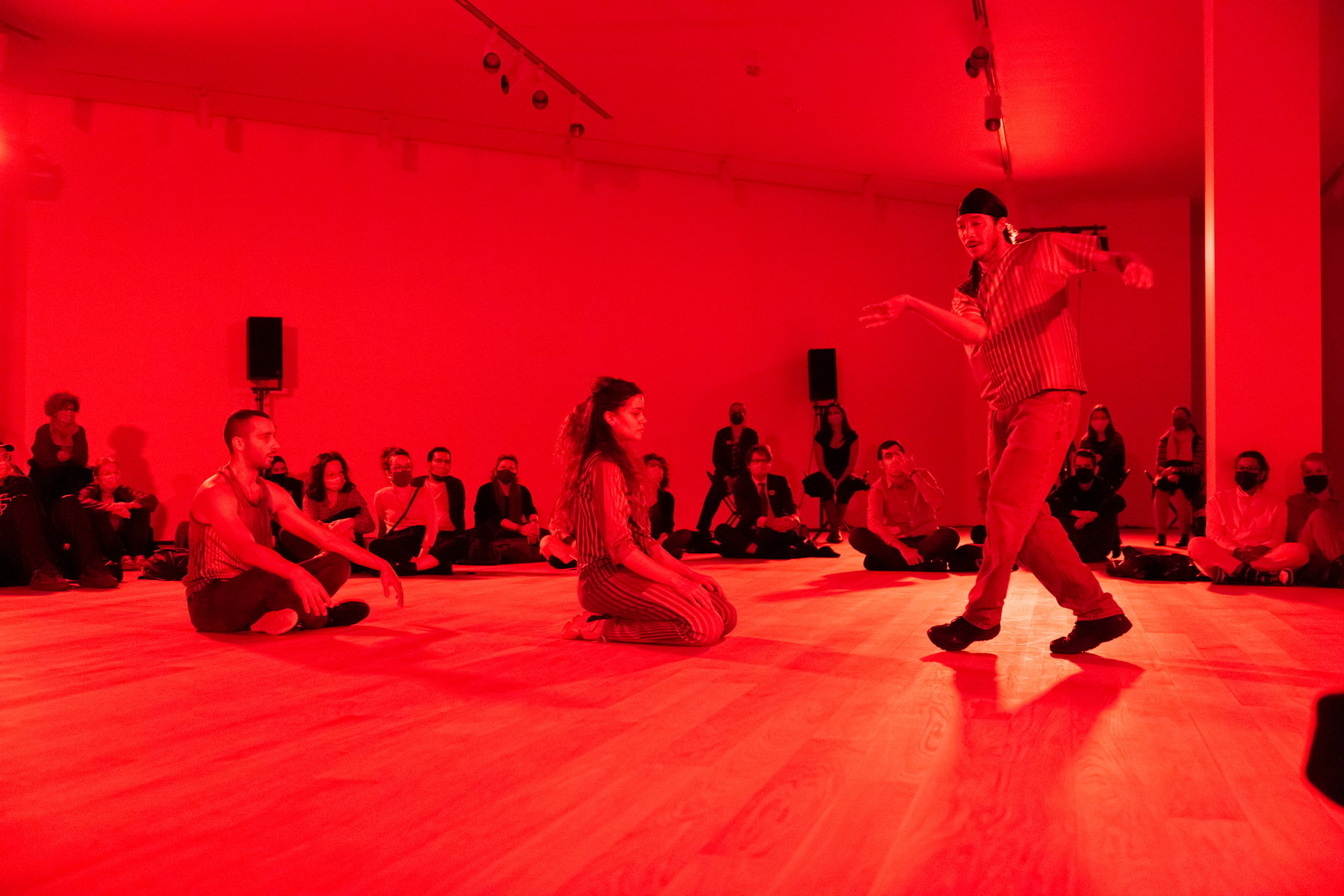
When the performing bodies are at rest, the room clears and Jenna allows space (and time) for the viewer to enter his environment. All day long. Surrounded by an immersive soundscape, projected invitations like “flow into stillness” or “don’t judge at this point” or longer “now grow into your plumb-line upward toward the ceiling or toward a favorite star” can be read on the white gallery walls. Some in the audience wonder if those lines are really addressed to themselves, or if it’s just a self-referential circle between the artist and himself. When I experienced this, more than half did not move from the supine or sitting position they were in after entering the room. A few brave ones took the time Jenna gave them and began to interact with the space around them. The others, who watched passively, looked at them as if wondering, “are they just childish to move around an empty room just because they find it written on a wall, or should I flow into the experience as well? Maybe it’s more foolish to stand still and stare at a screen. But maybe I can ‘flow into stillness’ even without getting up!”. What is certain is that even this kind of hesitation belongs to the time that Jenna gives to all of us.

